Intel Broadwell Architecture Preview: A Glimpse into Core M
by Ryan Smith on August 11, 2014 12:01 PM ESTPutting It All Together: Low Power Core M
So far we’ve discussed Broadwell’s architecture on a broad basis, focusing on features and optimizations that are fundamental to the architecture. However to talk about the Broadwell architecture is not enough to fully explain the Core M itself. Though many of Core M’s improvements do come from Broadwell, Intel has also made a number of alterations to everything from the CPU packaging to the process node itself specifically for Core M. It’s the resulting combination of these factors that has allowed Intel to iterate on Broadwell-Y over Haswell-Y, and why Intel is so confident in Broadwell-Y’s capabilities and suitability for mobile form factors.
When it comes to building and configuring Core M, Intel likes to refer to their efforts as the “Fanless Challenge,” reflecting the fact that their biggest goal with Core M is to comfortably get the processor in to 10” tablets under 10mm in thickness that are passively cooled. A big part of getting into such a device is meeting the heat dissipation limitations of the form factor – a 10” tablet under 10mm would require a sub-5W SoC – which is where a lot of Intel’s engineering efforts have gone. Broadwell’s performance optimizations, the GPU optimizations, GPU duty cycling, and the 14nm process all contribute to getting a Core CPU’s power consumption down to that level.
But even that’s still not enough, and for Core M Intel went so far as to give Broadwell-Y its own die and design a low-power optimized version of their 14nm process just for it. This variant is designed to further reduce power consumption by optimizing the resulting transistors for lower power, lower voltage, lower clockspeed operation. By doing this Intel was able to further reduce power consumption in all of the major areas over what would be a traditional 14nm Intel process.
In the resulting 14nm Broadwell-Y process, voltage, capacitance, and leakage were all improved over the traditional 14nm process. Capacitance was reduced by 15%, minimum operating voltages by 10%, and leakage was improved to the point that it reduced SoC power consumption by 10%. The combination of all of these factors serves to significantly lower power consumption over what Intel’s traditional 14nm process would provide.
Working in concert with Broadwell-Y’s 14nm process, Intel has made a number of other changes to further reduce power consumption. Some of these are reflected in Broadwell’s overall design and others are unique to Broadwell-Y, such as using a lower TjMax for Broadwell-Y. By reducing the maximum operating temperature of the chip Intel has been able to realize further power savings by further reducing voltage and decreasing the maximum amount of temperature-dependent leakage the SoC will experience.
Meanwhile Broadwell-Y’s partner in crime, the on-package PCH, has received its own optimizations to reduce power consumption on the SoC’s total power consumption. The PCH itself is not much of a power hog in the first place – it’s still made on Intel’s 32nm process for this and cost reasons – but with such a strong focus on power consumption every watt ends up counting. As a result the Broadwell PCH-LP has seen optimizations that cut its idle power consumption by 25% and its active power consumption by 20%. Further improvements to the PCH’s monitoring hardware also mean it’s more responsive and can be controlled to a finer degree than the Haswell PCH-LP, and Intel has upgraded to a faster audio DSP to improve performance and reduce power consumption there as well.
Feeding all of that silicon in turn is Intel’s second generation Fully Integrated Voltage Regulator (FIVR), which further builds off of Intel’s other optimizations. The 2nd gen FIVR has been tuned for Broadwell-Y’s lower voltages, making the FIVR itself more efficient when delivering power at those voltages. To accomplish this Intel has implemented non-linear vDroop control, which is designed to better control the voltage when workload changes would cause voltage overshoots that waste power. And when even the 2nd gen FIVR isn’t efficient enough, this latest FIVR offers a second mode (LVR Mode) for low voltage/workload situations where the FIVR can be partially bypassed to reduce the FIVR’s power consumption.
Interestingly Broadwell-Y also sees the voltage regulation inductors redesigned and relocated in both the name of power efficiency and space efficiency. We’ll get to the case of space efficiency in a moment, but for power efficiency the new 3D inductors (3DLs) have been placed on the underside of the package, allowing the use of more efficient inductors that waste less power.
This brings us to the final element of Intel’s power optimization efforts, which involve further adjustments to turbo boost as part of Intel’s “hurry up and go to sleep” motto. New for Broadwell-Y is a 3rd power state, PL3, which allows for even greater turbo boosting, but for only a very limited period of time – on the order of milliseconds. PL3 represents the maximum amount of power the device battery can deliver, and while it’s okay to reach this value sparingly, PL3 is a fast drain that is very hard on the battery. The existence of PL3 in this case is as much for battery protection as it is for performance; it allows devices to tap into PL3 power levels on occasion, all the while allowing PL2 (the regular burst limit) to be defined at a safer value below the battery’s limit. Put another way, by knowing PL3 devices know how to stay farther away from it, which in the long run is what’s best for battery reliability.


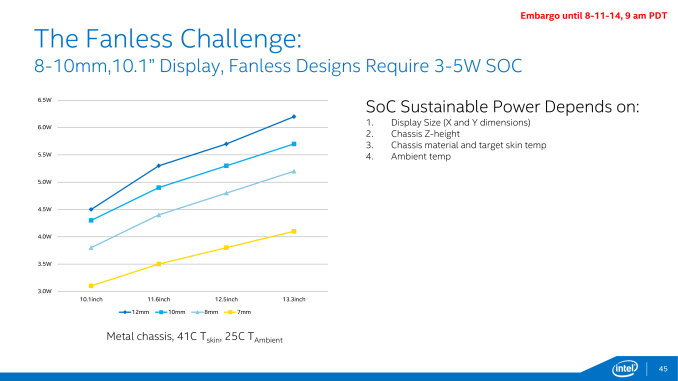
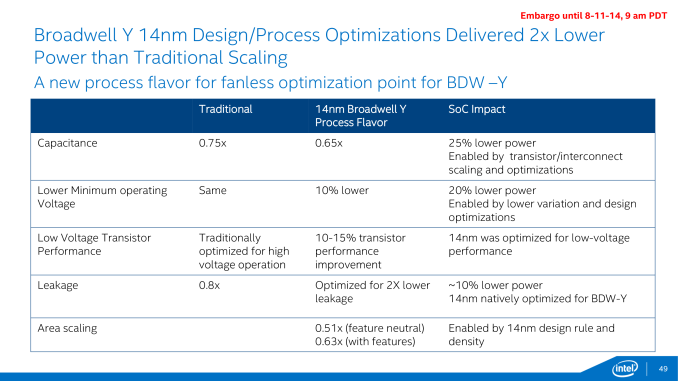
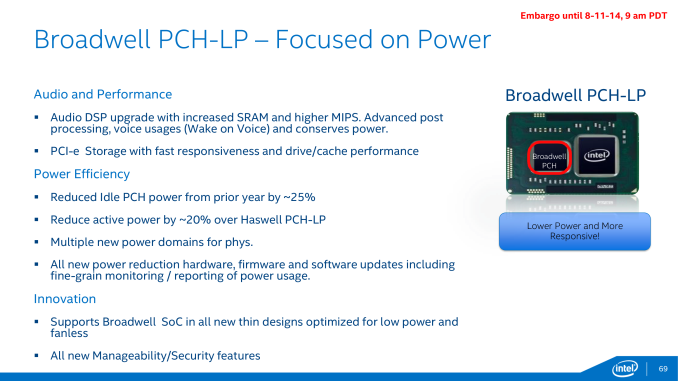
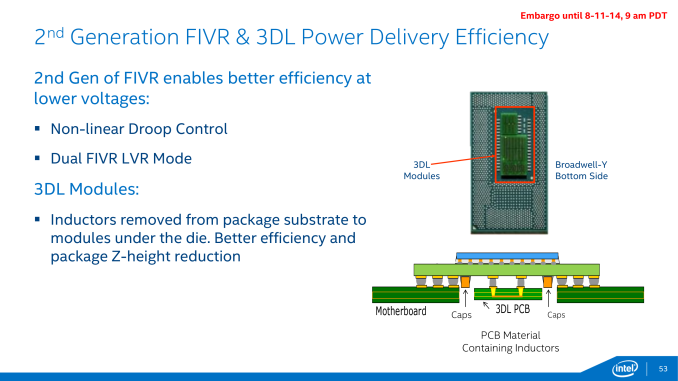

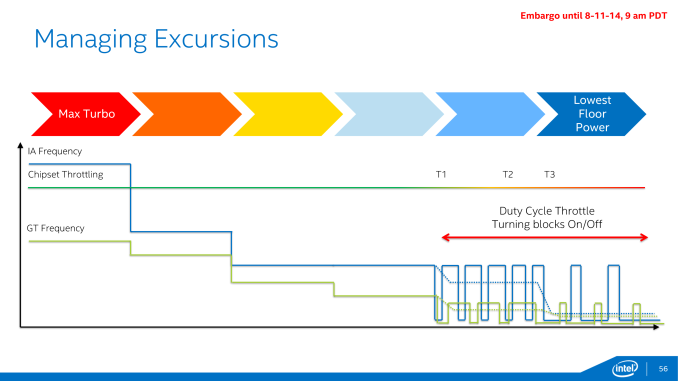








158 Comments
View All Comments
D. Lister - Saturday, August 30, 2014 - link
So you must be feeling pretty darn stupid now, realizing that you never had to buy the more expensive 3770K (plus the gtx680), since from your point of view it "feels" the same as an 8350 or an 8320 with an HD5850... eh? Here's an idea, sell your 3770K/GTX680 system, and buy an FX8320/HD5850... you would still get some of your money back - if you can't do that, then at least just shut the hell up and stop deliberately spreading misinformation, you unethical hypocrite.wintermute000 - Tuesday, August 12, 2014 - link
"well, an fx-8350 is toe-to-toe with an i7-2600k"You lost all credibility right there
wurizen - Tuesday, August 12, 2014 - link
no ididn't. u wish.wurizen - Tuesday, August 12, 2014 - link
u mean the credibility of anonymous internet opinions?rkrb79 - Tuesday, November 18, 2014 - link
Everyone can have their own opinions. Leave wurizen alone. Heaven forbid someone say something you don't agree with. Put on your big boy pants intel fanboys.tomsworkshop - Thursday, August 14, 2014 - link
Global Foundries was AMD spunoff fab, AMD still holding share on Global Foundries, Global Foundries are working tightly with Samsung fab right now for better manufacturing process, when they reach their goal in nm race they can compete with Intel in die shrink.FstEddie - Thursday, August 14, 2014 - link
Actually StevoLincolnite and others, you are quite confused. Using larger node sizes is not "cheaper to produce". Larger node sizes are more expensive per chip. The reason AMD (global foundries) does not just jump down to the next node is that it requires a great deal of capital up front (they are relatively broke) and R@D time which they are already behind on. Intel has proven more adept at shrinking process nodes and invests more in R&D ahead of time. This allows Intel to use the new node budget to partially increase performance, partially decrease power and partially decrease cost/chip. Cost per chip is the main driver for increasing density and depending on the generation Intel has re-balanced the performance/power/cost relationship.Samus - Wednesday, August 13, 2014 - link
I love what they did with the Z-height by embedding the chip "through" the motherboard PCB. That's really smart and will definitely improve thickness.beggerking@yahoo.com - Monday, August 11, 2014 - link
this looks to be very interesting... a true gaming windows 8.1/9 tablet laptop convertible in Surface Pro 3 form factor.A5 - Monday, August 11, 2014 - link
I'd hesitate to say that this will enable any kind of "real" gaming in the traditional sense. The iGPU isn't strong enough in this form factor, and AMD/NV draw too much power.